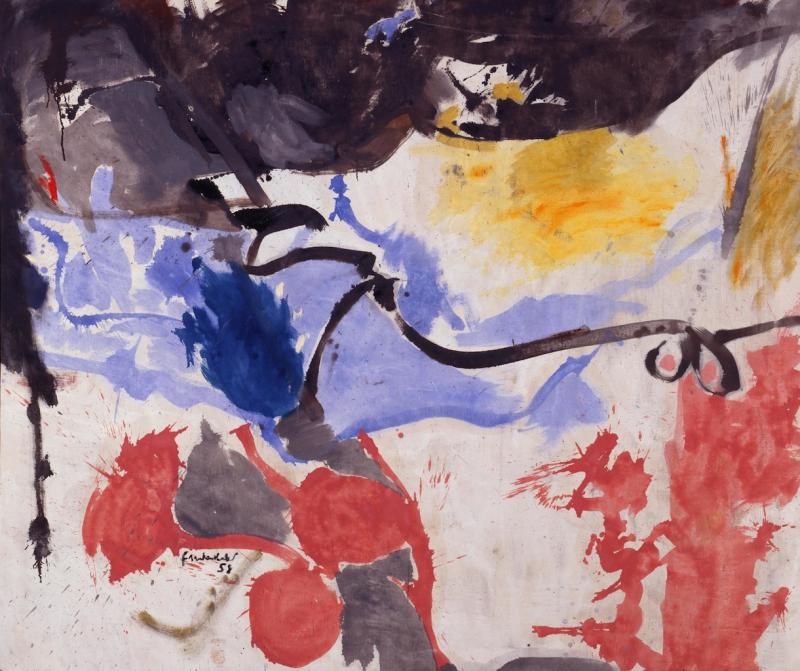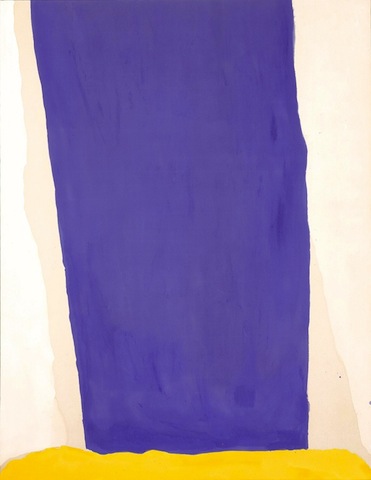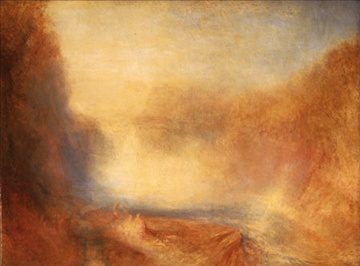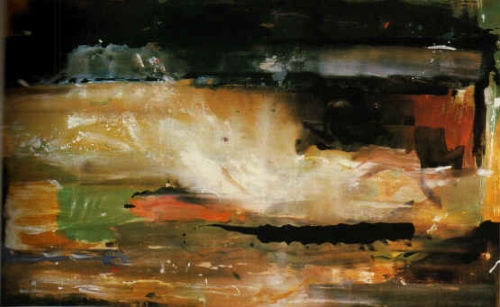Making Painting: Helen Frankenthaler and JMW Turner, Turner Contemporary | reviews, news & interviews
Making Painting: Helen Frankenthaler and JMW Turner, Turner Contemporary
Making Painting: Helen Frankenthaler and JMW Turner, Turner Contemporary
The American artist who provided a link between two postwar isms is shown to dazzling effect with English genius

Helen Frankenthaler is often presented as being both a stepping stone between art movements and as an artist who fell – because such things matter in the tidy narratives of art history – between the cracks of various American isms. Frankenthaler, who made her name in the fertile New York art scene of the early Fifties and who died in 2011, found success and fame early, but then had the possible misfortune to be seen as a “transitional figure”.
Since she created a bridge between Abstract Expressionism (specifically Pollock, with his drip technique) and later Color Field painting with her innovative staining method with thinned, poured paint, this is likely to have contributed to her slightly precarious reputation. That, and the fact that some critics later in her career saw her as too “poetic” in an age where beauty was considered problematic – in other words, too facile, in the end, to demand the kind of reverence afforded to her heavyweight predecessors (Rothko and Pollock among them) – as well as later “post-painterly abstractionists", such as Frank Stella. Later it was feminist theory (of the earth mother/womb-painting variety) that tried to claim her, making a case for the specific feminine nature of her work (the "soft" colours, the use of staining, stained red paint, with its suggestion of menstrual blood, that kind of thing).
 So much for her positioning. As anyone who’s actually seen her paintings will understand, the work simply dazzles. (It dazzles the eye, while nourishing the mind and there's nothing facile about that) And not only does it dazzle, but it demands prolonged engagement. But since we haven’t had a substantial exhibition of her work in the UK since 1969, when she was shown at the Whitechapel Gallery, engagement of any sort isn’t something we’ve had much of an opportunity to commit to (and the Tate owns no paintings by her, though it does have 38 prints, none of which, as far as I can see, are on display; it owns twice as many, including paintings, by Robert Motherwell, the husband she divorced in 1971). (Picured right: Blue Fall; © Milkwaukee Art Museum/Helen Frankenthaler Foundation)
So much for her positioning. As anyone who’s actually seen her paintings will understand, the work simply dazzles. (It dazzles the eye, while nourishing the mind and there's nothing facile about that) And not only does it dazzle, but it demands prolonged engagement. But since we haven’t had a substantial exhibition of her work in the UK since 1969, when she was shown at the Whitechapel Gallery, engagement of any sort isn’t something we’ve had much of an opportunity to commit to (and the Tate owns no paintings by her, though it does have 38 prints, none of which, as far as I can see, are on display; it owns twice as many, including paintings, by Robert Motherwell, the husband she divorced in 1971). (Picured right: Blue Fall; © Milkwaukee Art Museum/Helen Frankenthaler Foundation)
In the US, too, she wasn’t exactly over-exposed while alive, not once Minimalism and Pop art got underway. The Gagosian in New York held a museum-quality retrospective last year, but public galleries on either side of the Atlantic haven’t been clamouring to give her a major posthumous show either. What an injustice this seems in the light of Turner Contemporary’s small but revelatory show. Looking at reproductions doesn’t even hint at the transcendent quality of her paintings, revealed in their glory here. Her work reproduces very badly.
One can’t really say any of this about JMW Turner (even a Turner in reproduction is something to marvel at). Not only is Turner’s stature indubitably assured, but there have been more temporary displays of his work than you can shake a sable brush at, and they continue apace. Go to Tate’s Clore Gallery and you can bask in the luminescent glow of Turners the whole day long. Nobody’s complaining – who’s going to dispute his genius? Frankenthaler’s genius may be seen more in terms of “consolidation” rather than giant steps, but how truly rare is it to see to see paintings this alive. She uses colours with such a natural sense of harmony, and, my, those colours sing.
Frankenthaler no doubt was among the many who visited MoMA’s Turner exhibition in 1966, in which his later paintings, divested of their 19th-century frames, were reframed in the manner of contemporary painting. Links were made between him and the Abstract Expressionists. Much controversy ensued over such an ahistorical approach, but anyone passingly familiar with Turner's later work, and particularly his watercolour sketches, will know just how far he pushes into abstraction.
But we know Turner remained rooted in sea and landscape. And although Frankenthaler isn’t embedded in that tradition, the coast was often a starting point for her. This interest may seem a tad anachronistic, not just because this was postwar America and not the 19th century, but because she's such an urban, and urbane, artist. But like a number of New York artists at the start of the 20th century, those who were also forging a Modernist language long before her, she was hungrily drawn to the coast of the Eastern seaboard, and beyond. Her breakthrough painting, the 1952 Mountains and Sea was inspired by a trip to Nova Scotia, which juts out into the Atlantic. With its pale pink blushes, glowing ochres and delicate blue and green stains, we’re not invited to read this huge canvas, painted when she was just 23, as one depicting nature exactly, but, like Pollock, there is a sense of the elusively figurative, the organic and the primordial. But it has none of Pollock's density.
 The exhibition cautions us from making heavy weather of comparisons between these two artists separated by a century. Questions are raised, notions explored and aligned, but it’s all very open-ended and free, which feels a much more exciting method of discovery. The artists don’t share the same space, but Frankenthaler is given two galleries, and Turner a large third one, and so these can be treated as free-standing exhibitions. There is no blunderbuss curatorial agenda beyond the simple and refreshing one of just looking closely at two artists in whom abstraction and nature meet and coalesce. And when we’re confronted by a fiery painting such as the stand-out Falls of the Clyde (pictured above), 1840 (National Museums Liverpool; Lady Lever Art Gallery) we feel that the pairing isn’t so out on a limb.
The exhibition cautions us from making heavy weather of comparisons between these two artists separated by a century. Questions are raised, notions explored and aligned, but it’s all very open-ended and free, which feels a much more exciting method of discovery. The artists don’t share the same space, but Frankenthaler is given two galleries, and Turner a large third one, and so these can be treated as free-standing exhibitions. There is no blunderbuss curatorial agenda beyond the simple and refreshing one of just looking closely at two artists in whom abstraction and nature meet and coalesce. And when we’re confronted by a fiery painting such as the stand-out Falls of the Clyde (pictured above), 1840 (National Museums Liverpool; Lady Lever Art Gallery) we feel that the pairing isn’t so out on a limb.
Mountains and Sea isn’t in this selection, which takes us from the early Fifties to the early Nineties. But, intriguingly, a much smaller painting, New Jersey Landscape, painted in the same year but just a little earlier, is. This very small, blurred and blotted vista, which, like a wallflower among bolder playmates, hugs a corner of a wall, features smudgy, watery charcoal lines for trees, a foreground of dulled ochres and browns, with a bushy strip of green at the bottom edge and, above, a loose flurry of greys for sky.
It’s such a far cry from what's to come. But then Frankenthaler, though she never departed from what was soon to become her trademark staining technique, in which she poured thinned paint, initially oils, then acrylic, onto raw canvas, leaving the paint, blooming and thinning at the edges, to sink into the weave but remain luminous, wasn’t an artist who often repeated herself. We never see a signature style that sticks for long, certainly nothing like, say, the target paintings of Kenneth Noland, an artist who was, like Morris Louis, greatly influenced by the younger Frankenthaler. (Louis recalls the decisive encounter with Mountains and Sea in Frankenthaler's studio, calling it "the bridge between Pollock and what was possible".)
Since we range across four decades with only 24 paintings, taking a strictly chronological approach is wisely discouraged. So, in a wide corridor leading off into the main galleries, we find both Sands, 1964 and Barometer, 1992. The former utterly seduces in bold pink, deep blue, blood red ("menstrual red", if you prefer) and sandy browns, with areas of canvas left unstained, letting the image “breathe”. The latter canvas, meanwhile, with its impastoed blobs, smears and scrapes, makes you think of a turbulent sea in a harmony of white and greys (a brisk walk along the Margate coast afterwards is recommended). You'd barely imagine these two paintings are by the same artist.
 There are certainly a few “wow” moments – the dizzyingly bold Blue Fall, 1966 (pictured: above right) with its cascade of blue delicately positioned on a strip of golden yellow, offers one such moment. And then there are paintings which are more quietly stirring, such as the 1982 For E.M (pictured: above), a homage to Eduoard Manet, which appears to "transcribe", in abstract terms, a still life with fish. And then there’s the grave and sombre Burnt Norton, inspired by the grave and sombre poem in T.S Eliot’s Four Quartets.
There are certainly a few “wow” moments – the dizzyingly bold Blue Fall, 1966 (pictured: above right) with its cascade of blue delicately positioned on a strip of golden yellow, offers one such moment. And then there are paintings which are more quietly stirring, such as the 1982 For E.M (pictured: above), a homage to Eduoard Manet, which appears to "transcribe", in abstract terms, a still life with fish. And then there’s the grave and sombre Burnt Norton, inspired by the grave and sombre poem in T.S Eliot’s Four Quartets.
There is such an exhilarating sense of freedom in Frankenthaler’s work, just as you find in the late paintings of Turner. And this you get a further sense of when you actually watch her at work in her studio in the film that accompanies the exhibition – pouring paint, spreading it with a broom, smearing and blotting it with a thumb. All this, naturally, leaves you hungry for more (Tate, a retrospective, please). But for now, this is an encounter so much richer, so much more seductive, and so much more satisfying yet moreish, than I could have anticipated.
Explore topics
Share this article
The future of Arts Journalism
You can stop theartsdesk.com closing!
We urgently need financing to survive. Our fundraising drive has thus far raised £49,000 but we need to reach £100,000 or we will be forced to close. Please contribute here: https://gofund.me/c3f6033d
And if you can forward this information to anyone who might assist, we’d be grateful.

Subscribe to theartsdesk.com
Thank you for continuing to read our work on theartsdesk.com. For unlimited access to every article in its entirety, including our archive of more than 15,000 pieces, we're asking for £5 per month or £40 per year. We feel it's a very good deal, and hope you do too.
To take a subscription now simply click here.
And if you're looking for that extra gift for a friend or family member, why not treat them to a theartsdesk.com gift subscription?
more Visual arts
 'We are bowled over!' Thank you for your messages of love and support
Much-appreciated words of commendation from readers and the cultural community
'We are bowled over!' Thank you for your messages of love and support
Much-appreciated words of commendation from readers and the cultural community
 Folkestone Triennial 2025 - landscape, seascape, art lovers' escape
Locally rooted festival brings home many but not all global concerns
Folkestone Triennial 2025 - landscape, seascape, art lovers' escape
Locally rooted festival brings home many but not all global concerns
 Sir Brian Clarke (1953-2025) - a personal tribute
Remembering an artist with a gift for the transcendent
Sir Brian Clarke (1953-2025) - a personal tribute
Remembering an artist with a gift for the transcendent
 Emily Kam Kngwarray, Tate Modern review - glimpses of another world
Pictures that are an affirmation of belonging
Emily Kam Kngwarray, Tate Modern review - glimpses of another world
Pictures that are an affirmation of belonging
 Kiefer / Van Gogh, Royal Academy review - a pairing of opposites
Small scale intensity meets large scale melodrama
Kiefer / Van Gogh, Royal Academy review - a pairing of opposites
Small scale intensity meets large scale melodrama
 Jenny Saville: The Anatomy of Painting, National Portrait Gallery review - a protégé losing her way
A brilliant painter in search of a worthwhile subject
Jenny Saville: The Anatomy of Painting, National Portrait Gallery review - a protégé losing her way
A brilliant painter in search of a worthwhile subject
 Abstract Erotic, Courtauld Gallery review - sculpture that is sensuous, funny and subversive
Testing the boundaries of good taste, and winning
Abstract Erotic, Courtauld Gallery review - sculpture that is sensuous, funny and subversive
Testing the boundaries of good taste, and winning
 Edward Burra, Tate Britain review - watercolour made mainstream
Social satire with a nasty bite
Edward Burra, Tate Britain review - watercolour made mainstream
Social satire with a nasty bite
 Ithell Colquhoun, Tate Britain review - revelations of a weird and wonderful world
Emanations from the unconscious
Ithell Colquhoun, Tate Britain review - revelations of a weird and wonderful world
Emanations from the unconscious
 Rachel Jones: Gated Canyons, Dulwich Picture Gallery review - teeth with a real bite
Mouths have never looked so good
Rachel Jones: Gated Canyons, Dulwich Picture Gallery review - teeth with a real bite
Mouths have never looked so good
 Yoshitomo Nara, Hayward Gallery review - sickeningly cute kids
How to make millions out of kitsch
Yoshitomo Nara, Hayward Gallery review - sickeningly cute kids
How to make millions out of kitsch
 Hamad Butt: Apprehensions, Whitechapel Gallery review - cool, calm and potentially lethal
The YBA who didn’t have time to become a household name
Hamad Butt: Apprehensions, Whitechapel Gallery review - cool, calm and potentially lethal
The YBA who didn’t have time to become a household name
